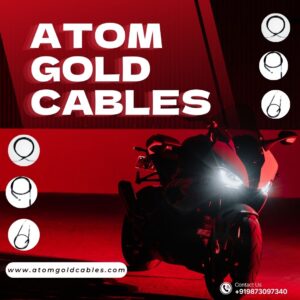When preparing for a long ride, inspecting your control cables is a crucial yet often overlooked step. Control cables are vital components in vehicles, responsible for managing critical functions like braking, steering, and acceleration. Failing to check them before a journey can lead to malfunctions that could compromise your safety on the road. By following a simple inspection checklist, you can identify wear and potential issues early, ensuring your control cables are ready for the journey ahead.
This guide provides a step-by-step checklist for inspecting control cables, helping you detect issues with wear, tension, lubrication, and alignment. This straightforward process will give you peace of mind and reduce the risk of cable failure during your ride.

1. Inspect for Visible Signs of Wear and Tear
The first step in checking control cables is to look for any visible signs of damage or wear. Over time, cables endure various stress factors like bending, extreme temperatures, and exposure to moisture, all of which can degrade their quality. Addressing these issues before they worsen can save you from potential breakdowns.
Common Signs of Wear and How to Spot Them
- Fraying or Broken Strands: Look for frayed or broken strands along the cable’s length. These are clear indicators of weakening that can compromise the cable’s strength.
- Corrosion or Rust: Exposure to rain, road salt, and other elements can cause corrosion or rust, especially on metal cables. Rust spots signal weakness and should be handled before they spread.
- Cracked Coating: Many control cables have protective coatings like PVC or nylon. Inspect the coating for any signs of cracking, peeling, or damage. Exposed metal can lead to further damage from moisture or friction.
Spotting these issues early can prevent unexpected failures and prolong the cable’s lifespan. If the damage looks serious, consider replacing the cable before starting your journey.
2. Test Cable Tension and Movement
After inspecting for visible wear, the next step is to check the tension and movement of the cable. Cables need a precise balance of flexibility and tightness to function properly. Loose cables can delay responses, while overly tight cables may break under pressure.
How to Test Tension and Movement
- Cable Tension: Gently pull on both ends of the cable. It should feel taut but not rigid. If it feels loose, it might require tightening. Loose cables can lead to sluggish response in braking or throttle control.
- Smooth Movement: Operate the cable by using the brake or throttle lever. The cable should move smoothly without feeling sticky or rough. If you sense any resistance, it might need lubrication or further inspection.
- Return to Position: After releasing the lever, the cable should return to its original position immediately. Any delay in return could indicate internal wear or alignment issues.
Regularly testing cable tension ensures they perform reliably, helping you avoid potential hazards while on the road.
3. Apply Lubrication to Reduce Friction
Keeping control cables well-lubricated is essential for smooth performance and durability. Proper lubrication minimizes friction, which helps the cables move easily and reduces the chances of wear over time.
Steps for Proper Cable Lubrication
- Choose the Right Lubricant: Use a lubricant designed for control cables, especially one that offers anti-corrosion benefits. Avoid using heavy grease, which can attract dirt and clog the cable.
- Apply Sparingly: Apply a small amount of lubricant along the cable, especially near joints and connections. Avoid over-lubrication, as excess lubricant can attract dust and grime.
- Remove Excess: Wipe off any excess lubricant with a clean cloth to keep the cable surface clean. Excess lubricant can trap dirt, which may harm the cable over time.
Proper lubrication will help your control cables function smoothly and last longer, especially during long rides.
4. Check for Proper Cable Alignment and Routing
For control cables to operate correctly, they must be aligned and routed properly. Misaligned or poorly routed cables can become strained or worn, reducing their effectiveness and longevity.
Steps to Ensure Proper Cable Alignment
- Trace the Cable Path: Follow the cable from end to end, ensuring it has a smooth, natural path. Avoid any sharp bends or tight turns, as these can strain the cable.
- Secure Attachments: Inspect all attachment points to ensure they are secure. Loose clamps or holders can allow the cable to shift, which may interfere with its movement.
- Check for Interference: Ensure the cable doesn’t rub against other vehicle parts. Friction from rubbing can cause wear, increasing the likelihood of cable damage.
Good alignment and secure routing minimize the stress on your control cables, improving both safety and performance during a long journey.
5. Test Cable Functionality Under Real Conditions
Finally, test your control cables in real conditions before setting out on your long ride. This step ensures that everything functions properly when the vehicle is in use, giving you a chance to make adjustments if necessary.
How to Test Cable Performance
- Simulate Real Usage: Test the cable’s function by engaging it as you would during your ride. For example, test the brakes, throttle, and clutch under typical conditions to ensure smooth and reliable performance.
- Listen for Unusual Sounds: Pay attention to any unusual sounds, such as squeaking or grinding, which could indicate internal wear or a need for lubrication.
- Monitor Responsiveness: Observe how responsive the cable is during use. Delayed or stiff responses might mean the cable is too tight, lacks lubrication, or has alignment issues.
Conducting a functional test helps you catch any last-minute issues and ensures your cables are in top shape for the journey.
Conclusion
Inspecting control cables may seem like a small detail, but it plays a big role in ensuring a safe and smooth ride. By checking for visible wear, testing cable tension, applying lubrication, ensuring proper alignment, and conducting real-condition tests, you can significantly reduce the risk of cable-related issues during your trip.
Following this checklist not only enhances your safety but also prolongs the life of your control cables, making every journey a safer and more enjoyable experience. Before setting out on a long ride, take the time to inspect your control cables—you’ll be glad you did!
Find the Atom Gold difference today – where the heritage of the past is merged with the technology of the future, and quality is the standard.
For more information about our products or to place an order, visit our website or contact us at our office in Ghaziabad, UP. Let us help you drive with confidence, powered by the best accelerator cables in the industry.
Visit us at -Shree Radha Nath Automotive Pvt Ltd , Plot No-35, NCR Industrial Park GT Road Sahibabad, Near Raj Bagh Metro Station, Ghaziabad, UP -201005. Mobile- 9873097340, 82870 63431 Ghaziabad, Uttar Pradesh, India 201005
